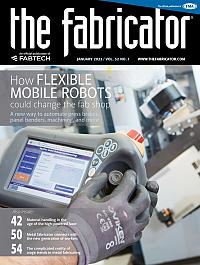Principal
- FMA
- The Fabricator
- FABTECH
- Canadian Metalworking
Categories
- Additive Manufacturing
- Aluminum Welding
- Arc Welding
- Assembly and Joining
- Automation and Robotics
- Bending and Forming
- Consumables
- Cutting and Weld Prep
- Electric Vehicles
- En Español
- Finishing
- Hydroforming
- Laser Cutting
- Laser Welding
- Machining
- Manufacturing Software
- Materials Handling
- Metals/Materials
- Oxyfuel Cutting
- Plasma Cutting
- Power Tools
- Punching and Other Holemaking
- Roll Forming
- Safety
- Sawing
- Shearing
- Shop Management
- Testing and Measuring
- Tube and Pipe Fabrication
- Tube and Pipe Production
- Waterjet Cutting
Industry Directory
Webcasts
Podcasts
FAB 40
Advertise
Subscribe
Account Login
Search
How metal manufacturers distinguish themselves through lean philosophy
On top of wages and benefits, what else can shops do to retain and attract workers?
- By Jeff Sipes
- January 14, 2022
- Article
- Shop Management

A lean manufacturing philosophy, on top of wages and benefits, can help set metalworking companies apart in ways current and potential employees value. Getty Images
Hiring and retaining employees is one of the most difficult challenges fabricators face today. Employees have more options and are in better positions to choose from among a buffet of compensation and workplace offerings. The fabricator can do only so much in terms of traditional monetary compensation.
Employees with skill have a buffet of compensation and workplace offerings. If you offer competitive wages and benefits, what else do you do to separate from the pack? What can you do to make it desirable for people to want to work for your company?
Beyond wages and benefits, what can you do to make it desirable for people to want to work for your company? Taking it a bit further, how do you entice employees with the key skills and workplace behaviors essential to your company’s success?
Let’s look at this issue from the lean perspective. Maybe you’ve just started down the lean path, or perhaps your lean program is well established and quite mature. Regardless, the lean philosophy can help set your company apart and provide a distinguishing factor that your current and potential employees value.
A Key Element of Lean Philosophy
Whether it be streamlining flow, using takt time to pace the operation, or creating standard work to minimize variation, the technical tools of lean help you to be objective and logical in how you work both “in the business” (the normal rhythm and flow of daily operations) and “on the business” (carving out time every day to improve the business by eliminating waste and reducing variation).
The technical tools by themselves are unlikely to entice, excite, and motivate current or potential employees to be enthusiastic and engaged—in other words, to create an environment in which they want to work nowhere else but your company. Even so, certain elements of the lean body of knowledge can spur enthusiasm and engagement, including several fundamentals that underpin the entire philosophy behind lean manufacturing: respect for people and operating with humility.
You might think this sounds soft and squishy, but never underestimate the power of respect and humility. They are essential for creating an environment where employees feel valued, wanted, and important. This is something everyone desires.
Creating and maintaining that environment is hard work for everybody involved. It may require adjustments from historical norms. Managers and supervisors may need to share some of their decision-making authority. Front-line employees may need to be more actively engaged in improving the processes they work in. Executives may need to spend time in the gemba (going and seeing where the value is created) to listen, learn, and actively support use of the lean body of knowledge. There is a lot of opportunity for all players in the company to demonstrate respect for people and operate with humility.
Distinguish Through Action
The hard work necessary to retain employees must be visible and action oriented. Words are important but by themselves do not get the job done. How do you turn soft and squishy language like “respect for people” and “operating with humility” into visible action? You must move beyond talk and demonstrate through action.
First, exercise your listening skills by intentionally listening to what employees have to say. Avoid talking over each other or acting like you are listening when you are really just queuing up your next brilliant point. People quickly see through the act of false listening and are likely to simply shut down. They will stop sharing ideas, show limited initiative, and probably just put forth the bare minimum of effort. What a waste of talent and resources.
Listening gets harder the farther you are from gemba, be it in the office or shop floor. The kind of questions you ask can encourage or discourage contribution and the sharing of ideas. Guide the conversation toward what’s substantive and important, but also remember that what is important to you may not be the same as what is important to the employee (at least at that moment in time).
If you’re talking about process improvement ideas, listen with all your attention and energy. You may learn something from the person who does the job all day, every day. Effective listening will help make employees feel valued and believe they have a stake in their outcomes. It is a win-win for both parties.
Of course, if you listen but don’t follow up with action, employees will respond with apathy or, more likely, negativity. The next logical step to distinguish through action is to employer employees to act. Their ideas need to be reasonable, of course. If they can use some of the technical tools of lean, see their ideas through to a fair evaluation or pilot implementation. If the idea is a no-go, explain why. Ideally, the employee should be directly involved in whichever direction the idea goes. At a minimum, keep the employee informed.
If an employee develops an idea that just doesn’t work—it could be unfeasible, unsafe, or inconsistent with the business strategy—then help the employee understand why. Never just walk away thinking that was a silly idea and leave the employee wondering. Keep doing that, and the employee will look for greener pastures. Empowering people is hard work for you and the leaders at your company, but the upside in a tight labor and skills market cannot be overlooked.
Invest in employees’ personal development so that they can develop skills and get retooled to participate in an evolving workplace. Help them grow, be more valuable to the organization, and give a boost to self-esteem. Invest in training, subsidize community college coursework, offer job rotations, and have them participate in formal kaizen events. Encourage everyday kaizen where lots of small improvements add up to substantial gains. Encourage and enable them to seek and achieve lean certifications (such as those offered through SME. Talk about recognition while doing good for both the employee and the employer.
What's in it for employees? They get the self-satisfaction of personal growth, the potential for advancement, as well as pride and recognition from their families. What’s in it for the company? The company gets less turnover and churn among employees at all levels, more employee satisfaction, and actionable improvement input.
These points are certainly not the complete list, but they do illustrate ways you can compete for employees in terms beyond wages and benefits. It takes a lot of hard work, but you can distinguish yourself through action.
Urgency to Operate Lean Has Never Been Greater
There is no reason to believe the demands of the labor and skills market are going to be any less difficult in the near future. As you have been exposed to and implemented the lean body of knowledge along your lean journey, you must understand the power of the lean ideas at work. The labor market’s tightness highlights the urgency for fabricators to distinguish themselves. Fabricators must be appealing to current and potential employees.
Employees have choices. If your company is competitive in terms of wages and benefits, then what do you do to separate from the pack? How do you compete on terms other than just dollars? This is where the lean body of knowledge comes into play. It can be beneficial for both the employee and the employer It is hard work, but the upside is worth it—and the cost of doing nothing might be devastating.
About the Author

Jeff Sipes
9250 Eagle Meadow Dr.
Indianapolis, IN 46234
(317) 439-7960
subscribe now

The Fabricator is North America's leading magazine for the metal forming and fabricating industry. The magazine delivers the news, technical articles, and case histories that enable fabricators to do their jobs more efficiently. The Fabricator has served the industry since 1970.
start your free subscription- Stay connected from anywhere

Easily access valuable industry resources now with full access to the digital edition of The Fabricator.

Easily access valuable industry resources now with full access to the digital edition of The Welder.

Easily access valuable industry resources now with full access to the digital edition of The Tube and Pipe Journal.
- Podcasting
- Podcast:
- The Fabricator Podcast
- Published:
- 04/16/2024
- Running Time:
- 63:29
In this episode of The Fabricator Podcast, Caleb Chamberlain, co-founder and CEO of OSH Cut, discusses his company’s...
- Trending Articles
AI, machine learning, and the future of metal fabrication

Employee ownership: The best way to ensure engagement

Steel industry reacts to Nucor’s new weekly published HRC price

Dynamic Metal blossoms with each passing year

Metal fabrication management: A guide for new supervisors

- Industry Events
16th Annual Safety Conference
- April 30 - May 1, 2024
- Elgin,
Pipe and Tube Conference
- May 21 - 22, 2024
- Omaha, NE
World-Class Roll Forming Workshop
- June 5 - 6, 2024
- Louisville, KY
Advanced Laser Application Workshop
- June 25 - 27, 2024
- Novi, MI


























